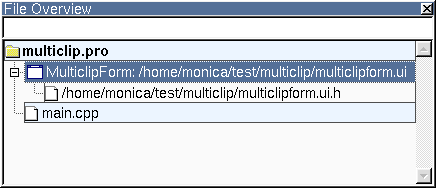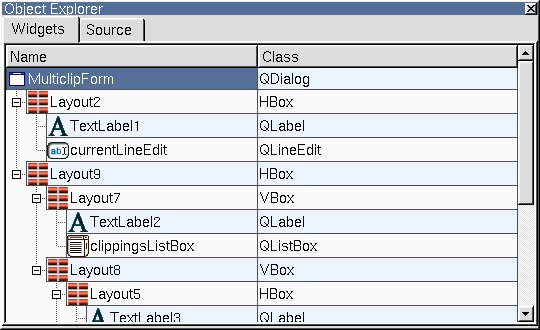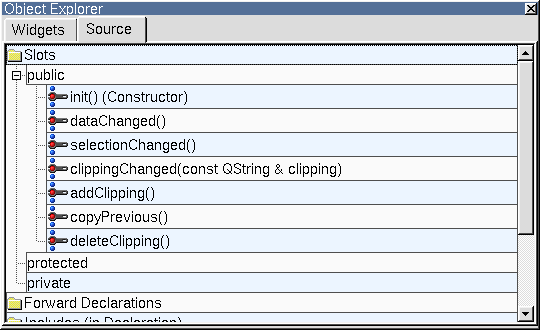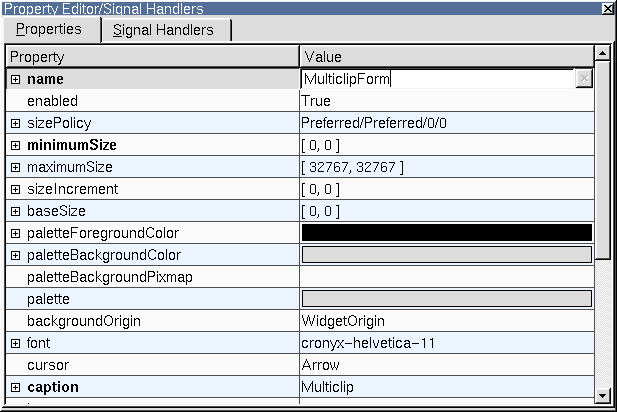| Home | All Classes | Main Classes | Annotated | Grouped Classes | Functions |  |
[Prev: Reference: Wizards] [Home] [Next: Reference: The .ui File Format]
Reference: Windows
Introduction
By default Qt Designer starts up with three windows on the left hand side. They are the File Overview Window, the Object Explorer Window, and the Property Editor/Signal Handlers Window. This chapter explains each window in detail.

File Overview Window
File Overview Window
This window lists all the files associated with the project. To open a form or file single click it in the Files list. To rapidly switch between forms and files, type the name of the file in the line edit above the files list and Qt Designer will perform an incremental search to show any matching files or forms.
Right-click a file (or the project) to get a context menu of options, for example, 'Open form' or 'Remove form from project'.
Object Explorer Window
The Object Explorer window lists the current form's widgets and slots. The window contains two tabs, the Widgets tab and the Source tab.

Widget Tab
Widget Tab
Click the Widgets tab to view all the widgets for the current form. The widgets are listed by name and class. Click a widget in the list to highlight it in the corresponding form.

Source Tab
Source Tab
Click the Source tab to view the current form's slots, forward declarations, includes, and class variables. The Source tab uses a tree view to display its information. Items which have a '+' sign have sub-items which are revealed by clicking the '+'. Right click any item in the tree view to popup a context menu.
To edit or add slots, right click the Slots folder and select 'Edit' to invoke the Edit Slots Dialog. Right click the Public, Protected, or Private subdirectories and click 'New' to invoke the Edit Slots Dialog. Right click a slot in the list to invoke a menu with additional options for the slot. To add new slots, choose 'New' from the menu, which invokes the Edit Slots Dialog. To change the properties of the selected slot, choose 'Properties' which invokes the Edit Slots Dialog. To open the C++ editor and jump to the implementation of the selected slot, choose 'Goto Implementation'. To remove the selected slot, choose 'Delete'. Signals can be added or deleted in the same way as slots.
Right click 'Forward Declarations', 'Includes (in declaration)', 'Class Variables', and 'Includes (in implementation)' to invoke a context menu with the 'new' or 'edit' options. Choose 'New' to invoke a line edit for typing a declaration, variable, or include. Right click 'Forward Declarations' and choose 'Edit' to invoke the Edit Forward Declarations Dialog. Right click 'Includes (in declaration)' and choose'Edit' to invoke the Edit Includes (in Declaration) Dialog. Right click 'Class variables' and choose 'Edit' to invoke the Edit Class Variables Dialog. Right click 'Includes (in Implementation)' and choose 'Edit' to invoke the Edit Includes (in Implementation) Dialog.
Property Editor/Signal Handlers Window
Click the Property Editor/Signal Handlers window to view and change the properties of forms, widgets and menus. This window has a 'Properties' tab and a 'Signal Handlers' tab.

Properties Tab
The Properties Tab
Click the 'Properties' tab to change the appearance and behaviour of the selected widget. (For menus, click the menu bar to show the menu item properties in the Property Editor.) The Property Editor has two columns, the Property column which lists property names and the Value column which lists the values. Click the column headers to sort the properties or values. Some property names have a plus sign '+' in a square to their left; this signifies that the property name is the collective name for a set of related properties.
Some properties have simple values, for example, the name property has a text value, the width property (within minimumSize for example) has a numeric value. To change a text value click the existing text and type in your new text. To change a numeric value click the value and either type in a new number, or use the spin buttons to increase or decrease the existing number until it reaches the value you want. Some properties have a fixed list of values, for example the mouseTracking property is boolean and can take the values True or False. The cursor property also has a fixed list of values. If you click the cursor property or the mouseTracking property the value will be shown in a drop down combobox; click the down arrow to see what values are available.
Some properties have complex sets of values; for example the font property. If you click the font property an ellipsis button (...) will appear; click this button and a Select Font dialog will pop up which you can use to change any of the font settings. Other properties have ellipsis buttons which lead to different dialogs depending on what settings the property can have. For example, if you have a lot of text to enter for a text property you could click the ellipsis button to invoke the multi-line text editor dialog. The names of properties which have changed are shown in bold. If you've changed a property but want to revert it to its default value click the property's value and then click the red 'X' button to the right of the value. Some properties have an initial value, e.g. 'TextEdit1', but no default value; if you revert a property that has an initial value but no default value (by clicking the red 'X') the value will become empty unless the property, e.g. name, is not allowed to be empty.
The property editor fully supports Undo and Redo (Ctrl+Z and Ctrl+Y, also available from the Edit menu).

Signal Handlers Tab
The Signal Handlers Tab
Click the 'Signal Handlers' tab to view or create the connections between signals of widgets and custom slots of the form.
[Prev: Reference: Wizards] [Home] [Next: Reference: The .ui File Format]
| Copyright © 2002 Trolltech | Trademarks | Qt version 3.0.5
|